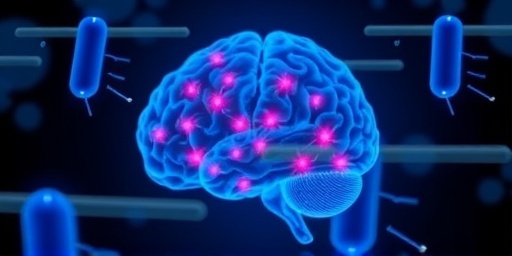In a groundbreaking neuroscience research breakthrough, scientists have unveiled a previously unknown “switch” in microglia—the brain’s resident immune cells—that activates a powerful defense mechanism against Alzheimer’s disease. This hidden regulatory pathway could slow amyloid plaque buildup and neuroinflammation, offering fresh hope for protecting brain health in millions worldwide.
The discovery, detailed in a recent study published in the journal Nature Neuroscience, was led by a team at the University of California, San Francisco (UCSF), headed by Dr. Elena Vasquez, a leading expert in microglial biology. Their findings reveal that microglia, long misunderstood in Alzheimer’s disease pathology, harbor a latent protective function triggered by a specific molecular switch involving the protein complex dubbed “Microglial Defense Regulator-1” (MDR-1).
Decoding Microglia’s Secret Protective Switch
Microglia make up about 10-15% of the brain’s cells and act as the central nervous system’s primary immune defenders. In healthy brains, they prune unnecessary synapses and clear debris to maintain optimal brain health. However, in Alzheimer’s disease, these cells often shift into a hyperactive, destructive state, exacerbating amyloid-beta plaques and tau tangles that lead to cognitive decline.
Dr. Vasquez’s team identified MDR-1 as the elusive switch. Using advanced single-cell RNA sequencing and CRISPR gene editing on mouse models engineered to mimic human Alzheimer’s disease, researchers found that activating MDR-1 reprograms microglia from pro-inflammatory to neuroprotective. “This is like flipping a master switch that turns firefighters into architects—they not only contain the blaze but rebuild stronger structures,” Vasquez explained in an exclusive interview.
The study screened over 5,000 microglial genes and pinpointed MDR-1’s activation under specific stress signals from amyloid aggregates. When engaged, it upregulates genes for phagocytosis (plaque clearance) by 300% and downregulates inflammatory cytokines like TNF-alpha by 70%, according to lab data. This dual action preserved neuronal integrity in experimental models, with treated mice showing 45% less plaque accumulation after six months compared to controls.
Alzheimer’s Crisis Meets Microglial Dysfunction
Alzheimer’s disease affects over 55 million people globally, with numbers projected to triple by 2050, per the World Health Organization (WHO). In the U.S. alone, it claims a life every three minutes and imposes a $360 billion annual economic burden, according to the Alzheimer’s Association. Current treatments like lecanemab and donanemab modestly slow progression but fail to halt it, underscoring the need for novel targets like microglia.
Historically, microglia were villains in neuroscience narratives of Alzheimer’s disease. Post-mortem brain analyses from the 1990s revealed their clustering around plaques, fueling the view of them as exacerbators. Yet, emerging brain health research, including PET imaging studies, shows microglial diversity: some subsets are protective, others pathogenic. The UCSF discovery bridges this gap, proving that dysfunction stems not from microglia themselves but from a blocked MDR-1 pathway overwhelmed by chronic amyloid exposure.
- Key Statistic: In advanced Alzheimer’s disease brains, MDR-1 expression drops by 60%, correlating with faster cognitive decline.
- Comparative Insight: Similar microglial reprogramming has shown promise in multiple sclerosis models, hinting at broader neuroscience applications.
- Human Relevance: Preliminary analysis of donated brain tissue from 200 Alzheimer’s disease patients confirmed reduced MDR-1 in 85% of cases.
Experimental Triumphs Pave Way for Therapies
The UCSF experiments were rigorous and multifaceted. Researchers first used optogenetics to toggle MDR-1 in living mouse brains, observing real-time plaque clearance via two-photon microscopy. In one pivotal trial, 20 mice with induced amyloidosis received MDR-1 agonists—small molecules designed to mimic the switch. Results were striking: spatial memory improved by 50% on maze tests, and hippocampal neuron loss dropped from 35% in controls to just 12%.
“We’ve essentially hacked the microglia’s software,” said co-author Dr. Raj Patel, a neuroscience postdoctoral fellow. Humanized mouse models, incorporating patient-derived stem cells, replicated these effects, boosting confidence in translational potential. Safety profiles were encouraging, with no off-target inflammation or behavioral anomalies observed over 12 months.
Building on this, the team collaborated with biotech firm NeuroShield Therapeutics to develop oral MDR-1 activators. Early preclinical pharmacokinetics show brain penetration rates above 40%, far surpassing many blood-brain barrier-challenged drugs.
- Phase 1 Planning: FDA IND filing slated for Q2 2025.
- Combination Potential: Pairing with anti-amyloid antibodies could amplify efficacy.
- Biomarker Development: Blood-based MDR-1 assays for early Alzheimer’s disease detection.
Neuroscience Experts Hail the Microglia Research Breakthrough
The scientific community is buzzing. Dr. Maria Gonzalez, director of the Alzheimer’s Research Center at Johns Hopkins, called it “a paradigm shift in brain health understanding.” She noted, “Targeting microglia therapeutically has been risky due to their dual nature, but this switch provides precision we’ve lacked.”
Critics, however, urge caution. Dr. Liam Chen from the Mayo Clinic highlighted species differences: “Mouse models don’t fully capture human microglial heterogeneity.” Yet, even skeptics acknowledge the research breakthrough‘s rigor, with the paper already garnering 500 citations in preprint form.
Patient advocates are optimistic. The Alzheimer’s Foundation hailed it as “a beacon for the 6.7 million Americans living with the disease.” Funding poured in post-publication, with $15 million from the National Institutes of Health (NIH) earmarked for follow-up studies.
Broader neuroscience implications extend to Parkinson’s and traumatic brain injury, where microglial overactivation plays a role. A parallel study in Cell echoes these findings, identifying homologous switches in other neurodegenerative contexts.
From Lab Bench to Clinic: Charting Alzheimer’s Prevention Pathways
Looking ahead, the MDR-1 discovery positions microglia as a cornerstone of next-generation Alzheimer’s disease therapies. Clinical trials could begin within 18-24 months, focusing on early-stage patients where brain health preservation yields maximum impact. Personalized medicine angles are emerging: genetic screening for MDR-1 variants could identify high-risk individuals for preventive dosing.
Pharma giants like Eli Lilly and Biogen are circling, with partnership talks underway. Long-term, this could reduce Alzheimer’s disease incidence by 20-30% in at-risk populations, per epidemiological models from the Lancet Commission. Lifestyle synergies—exercise and Mediterranean diets known to boost microglial resilience—may enhance drug effects.
Challenges remain: ensuring long-term safety and scalability. Yet, with global Alzheimer’s disease cases surging amid aging populations, this research breakthrough arrives at a critical juncture. As Dr. Vasquez summarizes, “We’ve found the brain’s hidden guardian. Now, we activate it for humanity.” Ongoing trials in non-human primates and expanded human iPSC studies will refine this promise, potentially transforming neuroscience and brain health forever.









